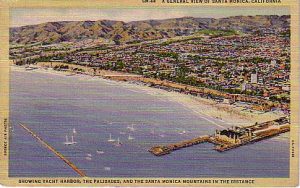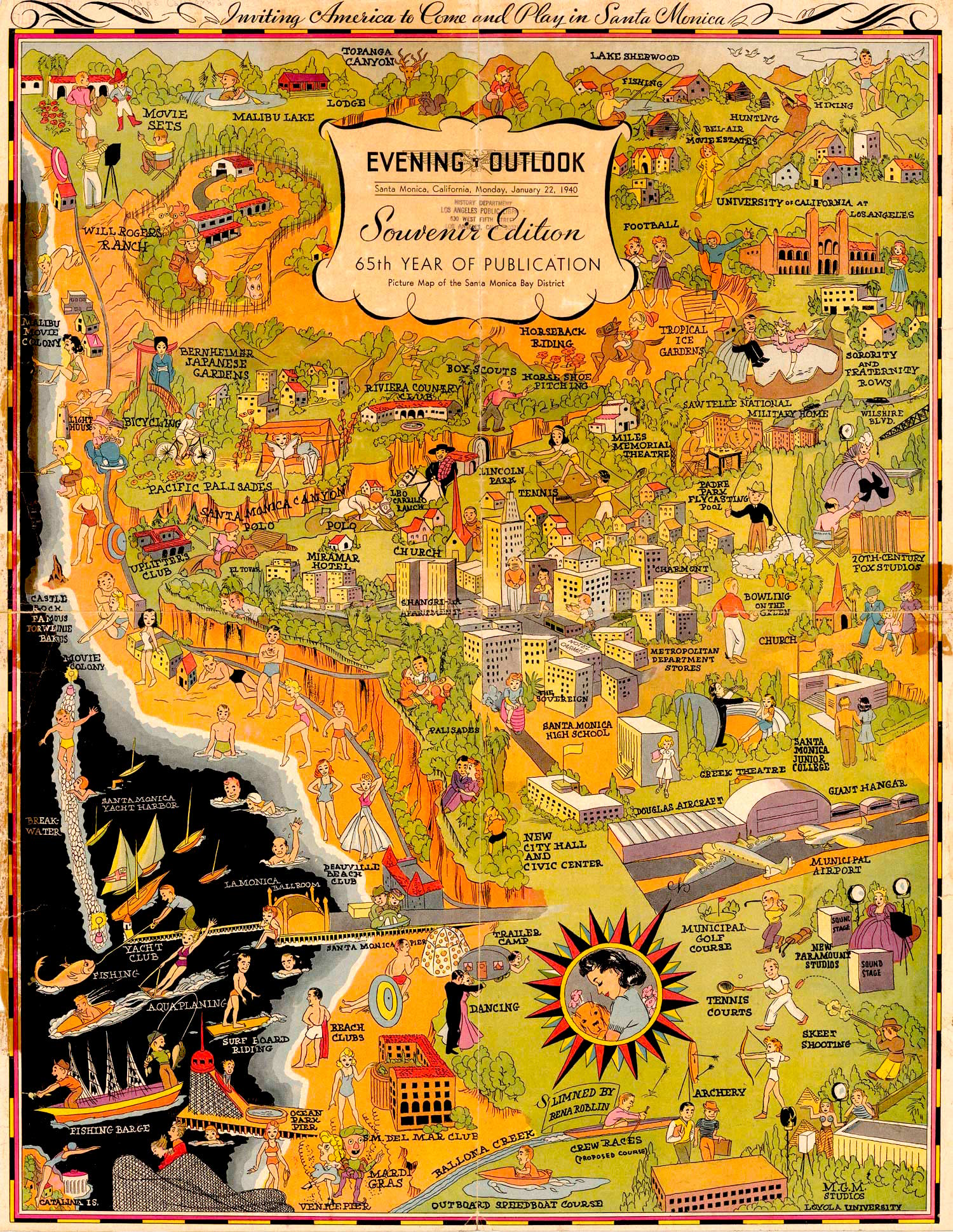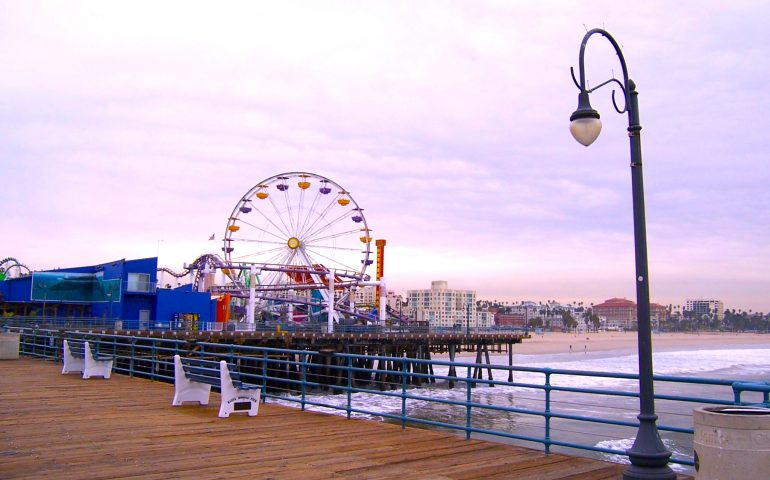In 1934, at the same time the new breakwater and harbor were being finished, the Municipal Pier was refurbished. 125 new piles were placed to enlarge the pier’s ‘T’ to 140-feet, a new lower deck was built for boat landings, and the pier’s top was resurfaced.
The Depression years of the thirties were rough years for the local amusement piers although visitors had their choice of pier fishing, Sportfishing from boats, amusements on the Looff Pier, water taxis to the fishing barges (and later to the gambling ships), and boating activities in the harbor. In the summer of 1934, Security First National Bank foreclosed on the Santa Monica Amusement Company. Later that year the city leased the La Monica Ballroom and converted it into a convention center and offices. By the spring of 1935 the amusement company filed for bankruptcy. In 1936 the bank, city and old amusement company were all in the courts and no one seemed to have a clear cut case for solution of the pier’s bills or various leases. So, off and on for a number of years, the bank would find itself in control of the pier. One result was conversion of the ballroom in 1937 into a roller rink.

1938 saw a new Sportfishing operation begin with the arrival of Bob Lamai and Preacher Scott Hume. Their boats included the Faith, Freedom and Pali, a small barge, Miss Dianna, and a charter boat Chi-Camoi.
In 1939 a new group of investors took over the Looff Pier. They were granted a 25-year lease by the city and began to order changes for the pier with the most drastic being a new carousel. By 1940 this group too would find the pier unprofitable, default on their mortgage and the bank would once again gain control of the franchise.
1939 was the year that construction of the 650-foot bridge connecting Colorado Avenue to the Municipal Pier began. It was opened on June 17, 1940. That same spring the pier was redecked as a WPA project. In 1941 the Santa Monica Pier Businessmen’s Association installed the arched neon sign at the entrance to the bridge that still welcomes today’s visitors.

Santa Monica — 1940
In 1940 Charles Arnold reopened his fishing barge. It was a sort of reverse osmosis when he bought the ex-gambling ship Texas. He soon gave it the same name as his former barge, Star of Scotland. However, the 261-foot-long boat sank off the pier during World War II.
The war years saw reduced activity at the pier although the mackerel fleet remained active in providing food for the war effort. However, in 1943, winter storms wrecked a number of fishing boats including the Sportfishing boat Palisades.
That same year also saw the bank sell the Santa Monica Pleasure Pier to Walter Newcomb the man who had taken over management of the pier at the start of the war. It now became the Newcomb Pier. At the time there were fifty-five businesses on the pier. In the spring of 1944, the La Monica Auditorium reopened as the Palisades Dance Hall but it soon closed. It could never gain the following of the La Monica Ballroom.
A frequent visitor to the pier was Johnny Weissmuller (Tarzan in the movies) who had been a lifeguard and enjoyed spending his afternoons paddleboard racing. His most memorable visit was on August 6, 1943, when he leaped from the pier and rescued a fifteen-year-old boy who was drowning.
The La Monica Ballroom finally reopened to large crowds at the end of the war when Spade Cooley the “King of Western Swing” rented it for his popular country-western band and began to use it for his live television program. By 1950 his show was the second most popular Los Angeles television program and he continued at the pier until 1954.
In 1946 Newcomb brought his 1922 Philadelphia Tobaggan carousel, PTC #62, to the pier after the Venice Pier closed. After renovation, it opened on June 27, 1947. 1946, also saw the first Santa Monica Fiesta at the Municipal Pier. Events included a Miss Santa Monica bathing beauty contest, paddleboard races, swimming exhibitions, acrobatics and gymnastic exhibitions. The latter had been held annually at Muscle Beach each Memorial Day weekend since 1935. In 1947 the event was enlarged with a large parade, and a Muscle Matinee complete with Mr. Santa Monica and Miss Muscle Beach titles.
Sportfishing operations at the Municipal Pier remained strong in the late ’40s and early ’50s. In 1948 Bob Lamia forced out his partner Preacher Scott Hume, but continued to operate the Sportfishing boats Palisades, Resista, Ramona, Sea Biscuit, Mardi Gras, W.K., and the fishing barges Tradewinds and North Wind.
In 1954 Lamia left and soon after Versal Schuler’s Santa Monica Sportfishing began to operate its fleet from the end of the pier. Schuler had previously operated out of the Ocean Park Pier. His boats included the Bright 1, Indiana, Maiden 1 & 2, Delaware, Jesabel, Pegasus and Kiaora.
Overall, the ‘50s seemed to generally be an era of decline for the piers, especially the Newcomb Pier after Walter Newcomb died in 1954. His widow continued to run the pier but few new attractions were added and some of the most famous features had lost their appeal. In 1955 the La Monica Ballroom became the Hollywood Autocade housing over 100 unusual cars. In 1963 the building was demolished.
$653,000 in repairs to the Municipal Pier (including replacing fifty-eight pilings, new decking, lighting, handrails and a new restroom were made in 1957. Then, in January of 1959 storms wrecked much of the remaining harbor and part of the pier; in May an additional storm damaged the Newcomb Pier.
In 1973 the city council voted to demolish both piers (since they were in need of expensive repair and seemingly had few amusements). It was a mistake by the council. A “Friends of the Santa Monica Pier” group was formed by merchants on the pier. They were soon joined by a citizens group, “Save Santa Monica Pier Citizen’s Committee.” The groups joined forces to defeat three of the council members who had voted against the pier and they were able to get the council to change its vote. Santa Monica took over operation of the Newcomb Pier in June of 1974. That same year saw a fire on the Newcomb Pier and a city authorization of $280,000 for Municipal Pier repairs. In 1975 voters passed a proposition that assured both piers would be preserved and on May 18, the Santa Monica Pier was dedicated as an official L.A. County Historical Landmark on Pier Day.
In January of 1976 work on restoration of the Newcomb Pier began (including replacing many of the pilings). Plans for several new restaurants were announced and the city bought the merry-go-round. But the late ’70s saw many of the plans put on hold due to delays caused by the Coastal Commission and the high interest rates of those years. Although the city spent $3.1 million on the pier between 1975 and 1980, plans were announced in 1981 to spend an additional $7.9 million for repairs and new attractions.
Unfortunately, a huge storm struck on January 27, 1983, which destroyed the northwest corner of the Municipal Pier and caused an estimated $2.5 million in damage to the pier. A second and more powerful storm then struck on March 1, a storm that did even more damage. 40 MPH winds, fifteen foot high waves, and the highest tides of the year combined their forces and by midnight the entire west end of the Municipal Pier had been destroyed and 45,000 square feet of the adjacent Newcomb Pier. Less than two-thirds of the 1,200-foot-long pier remained. Everything west of Moby’s Dock was gone and 20 percent of the pier’s total area was swept into the sea. Damage was estimated at $8.5 million. Included in the wreckage was the pier’s tackle shop and the boat landing and it would spell forever the end of Versal Schuler’s Santa Monica Sportfishing.
After the earlier mentioned talk and debate, construction on the new Newcomb Pier started in November of 1987. That project was completed in August of 1988. The new Municipal Pier opened on April 6, 1990 and just ten minutes after opening Robert Khourney, an eighteen-year-old angler, caught a thirteen-inch bass.
Since the earliest days, businesses have come and gone on the pier but it has retained enough elements of those bygone days to still attract a newer, less familiar generation of visitors. Today’s attractions include Pacific Park, a 12-ride carnival-style amusement park that helps Santa Monica retain the “pleasure pier” status that it has enjoyed for so long a time. Whatever the changes, the various businesses and attractions seem to work and a risorgimento of sorts has taken place. Today more than three million visitors a year visit the pier and it is one of the most visited piers in the state as well as an icon for the entire Los Angeles region. That’s true even though the nine-story-high Pacific Wheel, a Ferris wheel that was a centerpiece of the park, was auctioned off on eBay in 2008. The Ferris wheel, converted to solar power as one part of a program to turn Santa Monica into the nation’s first “Solar City,” was perhaps a little too tame for today’s visitor.
Of additional interest (I think) is Muscle Beach, the area south of the pier. It was originally named for the mussels that were attached to the pier pilings. In the early ’30s, the federal Work Progress Administration decided to build a weight lifting platform on the beach. The project’s dual purpose was to provide jobs for workers and provide a recreation area for Depression-era teenagers. Undoubtedly, someone, somewhere, felt that idle youth should be kept busy before their boredom turned to mischief—kind of like today’s Midnight Basketball Leagues. Eventually the area became home to circus performers, weight lifters, and unfortunately some of the seedier and more dangerous vagrants on the beach. A murder in 1956 and a rape in 1958 resulted in removal of the equipment although eventually Beach Park #4 was given some adult gymnastic equipment. Over time, the name was changed from Mussel Beach to Muscle Beach. Today, more people associate Muscle Beach with the beach area near the Venice Pier.
Santa Monica was named for holy Monica, the mother of Saint Augustine.
Santa Monica Pier Facts
Hours: Open 24 hours a day.
Facilities: There are lights, benches, fish-cleaning facilities and restrooms on the pier. Multi-level balconies allow anglers to fish closer to the water and they were designed to be wheelchair accessible. There is a bait and tackle shop by the end of the pier. There are several snack shops and restaurants on the shore half of the pier and the Mariasol Mexican food restaurant out toward the end. There is parking on the pier in a lot; the cost is $5-7 a day. There is metered parking on streets above the pier. Free concerts are held on the pier Thursday evenings in the summer months. For those worried about visiting the pier at night, a police station is now open near the entrance of the pier..
Handicapped Facilities: Handicapped parking but non-handicapped restrooms. The pier surface is cement and the rail height is 41 inches. Posted for handicapped.
Location: 34.0095897345215 N. Latitude, 118.49714040756226 W. Longitude
How To Get There: From I-405 take Santa Monica Blvd. west to Ocean Ave. Turn left, and go to Colorado Ave., and turn right onto the pier.
Management: City of Santa Monica.

Santa Monica brings back some good memories, especially when I would go with my younger nephew fishing under the restaurant at the end. Always caught something, even if the day sucked for other fishermen. Under the Mariasol, I have caught my fair share of black, walleye, shiner( not common) and rainbow perch alongside sargo, black croaker, sand and calico bass. Have also caught Bonito, mackerel, halibut, turbot, sharks and rays, and the odd eel or octopus and crabs. That pier has a lot depending on the season, though I have had some good luck with Corbina and yellowfin croakers on the north side in front of the arcade facing the breaker waves. Sand crabs and mussels are key. If you fish the middle part of the pier under the pilings on either north or south sides in the spring, one can get some solid sargo action off mussels, bloodworms, or ghost shrimp.